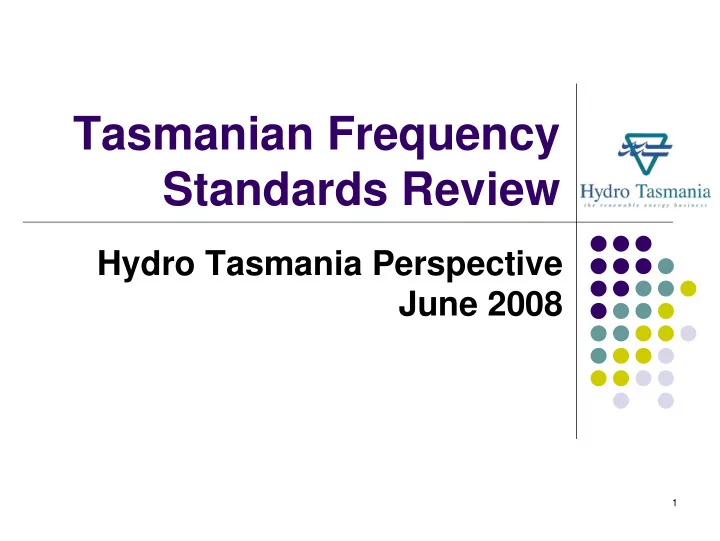

Tasmanian Frequency Standards Review Hydro Tasmania Perspective June 2008 1
Assessment of Options � Status quo (current standard) � Gunns, Tamar Valley Power (TVP) unable to connect � TVP proposed standard � Imposes very onerous design and operational requirements for Tasmania � Basslink import severely constrained � Net decrease in supply with Bell Bay closure � Basslink stranded in export � Major investment required in new fast raise services (up to $100 million) � Limited development of new wind in Tasmania 2
Assessment Conclusions � Neither standard alone provides increased supplies for Tasmania � TVP proposal decreases competition from Victoria by constraining Basslink � TVP proposal results in tighter standard plus increase in contingency size which causes significant increase in FCAS requirement and cost Reliability Panel must take a broader view to find a package of measures which work and provide long term investment certainty 3
Key Issues � Tighter standard � Increases FCAS requirements � Impacts Basslink capability � Increases system security risk (UFLS,OFGS,SPS) � Add significant redesign cost (UFLS,OFGS,SPS) � Contingency Size � Not covered by NER � Larger contingency exacerbates FCAS raise supply issues � No dispatch co-optimisation � Creates Basslink dispatch issues 4
FCAS R6 Requirement Tasmanian system Demand (MW) 900 1000 1400 1800 Inertia (MWs) 4500 4600 7300 9700 47.5 Hz 95 90 67 47 144 MW Contingency 48.0 Hz 126 117 82 65 210 MW 47.5 Hz 225 211 132 109 Contingency 48.0 Hz 307 291 160 129 Source: NEMMCO advice to RP 2008 5
FCAS R6 Supply FCAS (R6) trapezium for 1000MW Tasmanian system efficient dispatch FCAS R6 capability Max R6 in dispatch 120 Operating point Actual R6 available in bids 80 1000 1100 Generation dispatched 6
FCAS Transport on Basslink No FCAS transfer Maximum local raise required Maximum local raise required No-go Local raise zones A B 50MW 50MW No local requirement No local requirement Start of import constraint Start of reversal constraint (=Total R6 required minus local supply) (=Total R6 required minus local supply) 594MW Basslink imports 0 to 478MW Basslink exports 0 to 594MW 478MW 0MW (metered) (metered) 7
FCAS (R6) Table Tasmanian FCAS (Raise) requirements for generating unit contingency under import conditions New max Tasmanian Demand 1000 1400 No FCAS transfer Tasmanian Inertia 4600 7300 Local raise No-go 47.5Hz, 144MW loss 67 90 zones Current max 48.0Hz, 144MW loss 117 82 211 132 47.5Hz, 210MW loss 50MW 50MW Start of import constraint 48.0Hz, 210MW loss 291 160 (=Total R6 required minus local supply) 478MW Basslink imports 0 to 478MW (metered) 0MW Tasmanian FCAS (Raise) requirements FCAS (R6) trapezium for 1000MW and 1500MW for reversal from export Tasmanian system efficient dispatch No FCAS transfer Actual R6 in bids at New max Max R6 in dispatch operating points FCAS R6 capability No-go zones Current max 162 120 90 80 50MW 50MW Start of reversal constraint (=Total R6 required minus local supply) 1000 1100 1500 1600 Generation dispatched Basslink exports 0 to 594MW 594MW 0MW (metered) 8
What does all this mean? � Basslink imports reduced by up to 200MW � Basslink stranded in export � Net energy supply for Tasmania may decrease 9
FCAS Raise Market in Tasmania � Small revenue stream for suppliers � Relatively high cost of supply � Generators provide and pay for service � Costs can only be recovered around 10% of the time when Basslink can’t transport cheap mainland FCAS R6 No market incentive for investment 10
FCAS R6 Possible Supply Options 900 800 700 600 $000 500 /MW 400 300 200 100 ? 0 s t e s n y g S s l r e B r e n o n e P m e i R t o t l i U h p t c e p V a w u a v s B l o e p y o e c s l a r R d F e p c i c c i m d i r D A t e e n I p n a d r u o i m a K S n e e r L e D v o G 11
New Zealand Experience � $2bn energy & $50-100m FCAS markets � Costs and additional penalties (non-compliance) are attributed to the users of FCAS � FCAS is provided by generators and interruptible loads (around 50/50 split) � Co-optimisation of largest unit occurs as a market outcome � UFLS is used for multiple contingency events; purchased similar to FCAS � NZ has different features and hence different standards on each island 12
Summary � Issues � Tighter standard and larger contingency will cause severe R6 supply problems and operational problems � Increased reliability risk � Increased security risk Wind development in Tasmania will be constrained � � Hydro Tasmania Proposal � Maintain current frequency standard � Limit the contingency size to 144MW � Innovative solution to allow Gunns and Tamar Valley Power to connect 13
Recommend
More recommend